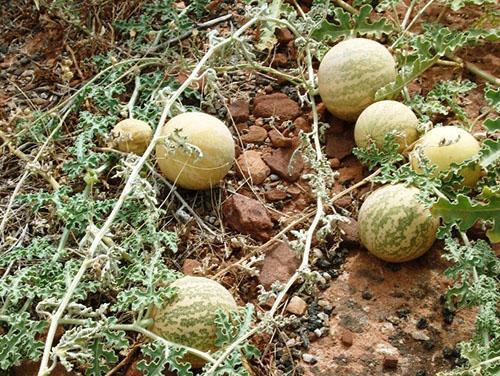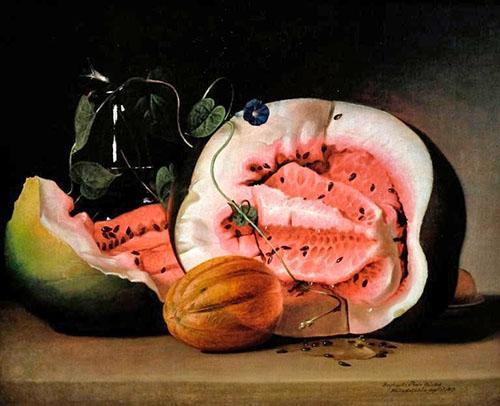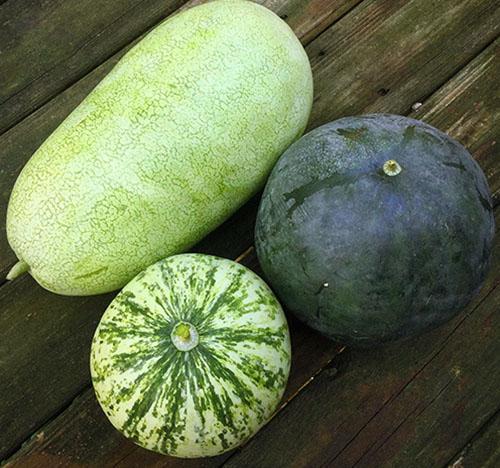Photos and descriptions of common and unique varieties of watermelons
 Wild ancestors of modern sweets watermelons and to this day grow in the desert dry valleys of Botswana, Namibia, South Africa and other countries in the region. Unlike cultivated varieties, wild plants can be called neither sugar nor large. The pale yellow or white flesh inside 250-gram fruits is either fresh or even bitter.
Wild ancestors of modern sweets watermelons and to this day grow in the desert dry valleys of Botswana, Namibia, South Africa and other countries in the region. Unlike cultivated varieties, wild plants can be called neither sugar nor large. The pale yellow or white flesh inside 250-gram fruits is either fresh or even bitter.
Watermelon transformation

Attempts to obtain larger and sweeter fruits were made in ancient Egypt; watermelons were grown in India, Persia and China. Culture did not spread to Europe earlier than the 16th-17th centuries, and those varieties of watermelons, as in the photo of one of the still lifes of that era, were much inferior to fruits ripening in modern beds in terms of sweetness, juiciness and color of the pulp.
 Only in the last hundred years have breeders been able to get an incredible number of new varieties and hybrids, giving gourmets the opportunity to taste the pulp not only of a red or pink hue, but also of yellow or almost white. And the bark of watermelons in today's beds can be not only dark green or striped, but also yellow, white, spotted or with a marble pattern.
Only in the last hundred years have breeders been able to get an incredible number of new varieties and hybrids, giving gourmets the opportunity to taste the pulp not only of a red or pink hue, but also of yellow or almost white. And the bark of watermelons in today's beds can be not only dark green or striped, but also yellow, white, spotted or with a marble pattern.
 Summer residents and farmers are offered several hundred cultivars and hybrid forms that yield sweet fruits weighing from one to 90 kilograms. What are the varieties of watermelons shown in the photo "Carolina Cross ”, growing on average up to 30-50 kg, but sometimes reaching a weight of almost 200 kg.
Summer residents and farmers are offered several hundred cultivars and hybrid forms that yield sweet fruits weighing from one to 90 kilograms. What are the varieties of watermelons shown in the photo "Carolina Cross ”, growing on average up to 30-50 kg, but sometimes reaching a weight of almost 200 kg.
The era of Astrakhan watermelons
 In Russia, watermelons have long been grown in Little Russia, in the Kuban and in the south of the Volga region, where weather conditions allowed large sweet fruits to ripen. In Soviet times and until now, watermelons from near Astrakhan were in special respect and demand among buyers. The phrase "Astrakhan watermelon" meant that under a thin crust there would be a scarlet, sugary pulp of inimitable sweetness and aroma.
In Russia, watermelons have long been grown in Little Russia, in the Kuban and in the south of the Volga region, where weather conditions allowed large sweet fruits to ripen. In Soviet times and until now, watermelons from near Astrakhan were in special respect and demand among buyers. The phrase "Astrakhan watermelon" meant that under a thin crust there would be a scarlet, sugary pulp of inimitable sweetness and aroma.
This area was considered the main melon of the Soviet Union, and the main variety on the plantation was the Astrakhansky watermelon.
The first harvest of oval-shaped striped fruits was obtained in 1977, at the Astrakhan Institute of Vegetable and Melon Growing. The watermelons ripening 70–80 days after sowing turned out to be so productive that up to 120 tons of sugar watermelons were harvested from a hectare of melons, which, moreover, could be stored for up to 2.5 months and could be easily transported. These circumstances made Astrakhan watermelons the most popular and beloved in the country.
Volgograd watermelons from the village of Bykovo
 The second place in the number of cultivated melons and gourds in Russia is occupied by the Volgograd region. Here, on the basis of the only specialized melon plant in the USSR, Bykovskaya selection and experimental station, such famous varieties of watermelons were obtained, in the photo as Holodok, Bykovsky 22, Triumph and more than four dozen more unpretentious to the conditions of the zone of risky agriculture and very productive varieties of everyone's favorite culture.
The second place in the number of cultivated melons and gourds in Russia is occupied by the Volgograd region. Here, on the basis of the only specialized melon plant in the USSR, Bykovskaya selection and experimental station, such famous varieties of watermelons were obtained, in the photo as Holodok, Bykovsky 22, Triumph and more than four dozen more unpretentious to the conditions of the zone of risky agriculture and very productive varieties of everyone's favorite culture.
The Volgograd watermelon is still considered a masterpiece of melon breeding. Chill of late ripening, easily stored until the New Year, and during this time does not lose either its excellent taste or juiciness. For cultivation in summer cottages garden beds this variety is most often chosen.
Watermelon Crimson Sweet
 If Soviet and Russian breeders followed the path of obtaining varieties of watermelons that are most resistant to all the vicissitudes of the local climate, then foreign biologists have a somewhat different goal in the first place. Here, the greatest demand is for large-fruited, spectacular in shape and color of bark and pulp, watermelons with high consumer and commercial qualities and high disease resistance. True, to grow a good harvest in this case, you will have to spend more effort and make a lot fertilizers.
If Soviet and Russian breeders followed the path of obtaining varieties of watermelons that are most resistant to all the vicissitudes of the local climate, then foreign biologists have a somewhat different goal in the first place. Here, the greatest demand is for large-fruited, spectacular in shape and color of bark and pulp, watermelons with high consumer and commercial qualities and high disease resistance. True, to grow a good harvest in this case, you will have to spend more effort and make a lot fertilizers.
Of the foreign varieties, our summer residents are best known for the Crimson Sweet watermelon, obtained by American breeders. The fruits of this variety are not large in size and on average weigh up to 5 kg. The variety, outwardly similar to the famous Astrakhan watermelon, has a moderate sweetness and gives stable yields in 65–80 days.
On the basis of the popular variety of watermelon Crimson Sweet, many varieties have been obtained over the years, larger than the ancestor, and also capable of shelf life.
Sugar Baby: Watermelon Suga Baby
 Another old foreign variety known in Russia, Suga Baby or Sugar Baby, gives round dark green fruits with red pulp 75–80 days after planting. Watermelon Sugar baby outwardly resembles the Ogonyok, famous among summer residents, but somewhat larger. Sugar Baby watermelons weigh from 3 to 4.5 kg, and their flesh is distinguished by pronounced granularity and sweetness.
Another old foreign variety known in Russia, Suga Baby or Sugar Baby, gives round dark green fruits with red pulp 75–80 days after planting. Watermelon Sugar baby outwardly resembles the Ogonyok, famous among summer residents, but somewhat larger. Sugar Baby watermelons weigh from 3 to 4.5 kg, and their flesh is distinguished by pronounced granularity and sweetness.
If the Ogonyok variety, which appeared in the USSR back in 1960, became known in the West, perhaps its round fruits with a dark bark without stripes would be called "black watermelon". And in Japan, Ogonyok could compete with the most expensive Densuke watermelon in the world with the same rich color peel, and it is thanks to it that costs up to $ 250 apiece.
Moon and stars on a watermelon peel
 Obviously, on the basis of some old variety of black watermelon in 1926 in Missouri, a variety with the romantic name "Moon and Stars" was obtained. Bright yellow spots of different sizes are scattered over the black-green bark of this watermelon and even over the foliage, reminiscent of night lights against the background of the night sky.
Obviously, on the basis of some old variety of black watermelon in 1926 in Missouri, a variety with the romantic name "Moon and Stars" was obtained. Bright yellow spots of different sizes are scattered over the black-green bark of this watermelon and even over the foliage, reminiscent of night lights against the background of the night sky.
For almost a century, this variety of watermelon, as in the photo, remains popular, and today there are hybrids not only with pink-red, but also with yellow pulp. Not uncommon among the "star" fruits and elongated watermelons, which are popular among consumers, weighing from 9 to 23 kg.
Marble watermelon
 Another variety of fruits, due to a thin network of dark green veins on a light background of the bark, is called marble watermelons. Usually these are oblong watermelons weighing from 5 to 15 kg with juicy, pink or red flesh, few seeds and excellent taste.
Another variety of fruits, due to a thin network of dark green veins on a light background of the bark, is called marble watermelons. Usually these are oblong watermelons weighing from 5 to 15 kg with juicy, pink or red flesh, few seeds and excellent taste.
 An example of a marbled watermelon is the French variety Charleston Gray, which gave rise to a whole family of fruitful orts and hybrids. Russian breeders do not lag behind their Western colleagues and presented to gardeners the early-ripening Honey Giant, a watermelon variety, as in the photo, giving large fruits up to 60 cm long and weighing up to 15 kg, well withstanding drought and common crop diseases.
An example of a marbled watermelon is the French variety Charleston Gray, which gave rise to a whole family of fruitful orts and hybrids. Russian breeders do not lag behind their Western colleagues and presented to gardeners the early-ripening Honey Giant, a watermelon variety, as in the photo, giving large fruits up to 60 cm long and weighing up to 15 kg, well withstanding drought and common crop diseases.
White watermelons can be sweet
 While the bark of marbled watermelons has a light green hue with a subtle pattern, the peel of the American variety Navajo Winter is almost white.
While the bark of marbled watermelons has a light green hue with a subtle pattern, the peel of the American variety Navajo Winter is almost white.
The flesh of this white watermelon can be either pink or red, but it is necessarily crispy and very sweet. The variety is considered drought-resistant, and the fruits are easily stored for up to 4 months.
 If gardeners and consumers have already got used to the multi-colored peel of watermelons, then the white or yellow pulp of these sweet fruits is still a wonder for Russians. But it is precisely such unusual hybrids obtained from the crossing of cultivated varieties of watermelons and wild-growing varieties that are at the peak of popularity and can have pulp of all shades from creamy orange, yellow to translucent white.
If gardeners and consumers have already got used to the multi-colored peel of watermelons, then the white or yellow pulp of these sweet fruits is still a wonder for Russians. But it is precisely such unusual hybrids obtained from the crossing of cultivated varieties of watermelons and wild-growing varieties that are at the peak of popularity and can have pulp of all shades from creamy orange, yellow to translucent white.
 True, sometimes, under the guise of a white watermelon, gullible summer residents are offered Peruvian fig-leaved pumpkin, ficifolia, both in the shape of the foliage and in the appearance of the fruit, reminiscent of a marbled watermelon, but not able to compete with it in sweetness.
True, sometimes, under the guise of a white watermelon, gullible summer residents are offered Peruvian fig-leaved pumpkin, ficifolia, both in the shape of the foliage and in the appearance of the fruit, reminiscent of a marbled watermelon, but not able to compete with it in sweetness.
What does yellow watermelon taste like?
 Watermelons with yellow flesh are now offered to customers under the name pineapple, although the similarity of these fruits is limited only by the beautiful shade of the slices, and the color change does not affect the taste of yellow watermelon.
Watermelons with yellow flesh are now offered to customers under the name pineapple, although the similarity of these fruits is limited only by the beautiful shade of the slices, and the color change does not affect the taste of yellow watermelon.
Russian breeders offer summer residents to try pineapple watermelons collected from their own beds. Watermelons of the Lunny variety are ready to harvest in 70–75 days from the moment of sprouting. Fruits with an attractive striped skin grow up to 3.5-4 kg and have excellent taste characteristics.
The hybrid of domestic selection Prince Hamlet F1 is not only distinguished by early maturity. Its main "highlight" is hidden under the dense thin bark. The pulp of this pineapple watermelon weighing up to 2 kg is lemon yellow, sweet.
 But the variety of watermelon, in the photo, Gift of the Sun can be easily confused not with pineapple, but with melon, since the fruits of this plant have a surprisingly yellow smooth bark, very reminiscent of the peel of another popular melon culture. This yellow watermelon, due to the accumulation of up to 12% sugar, has a great taste, juicy pulp consistency and early ripening.
But the variety of watermelon, in the photo, Gift of the Sun can be easily confused not with pineapple, but with melon, since the fruits of this plant have a surprisingly yellow smooth bark, very reminiscent of the peel of another popular melon culture. This yellow watermelon, due to the accumulation of up to 12% sugar, has a great taste, juicy pulp consistency and early ripening.
 Today, breeding companies in Holland, the USA and Japan are actively working in the field of obtaining diploid hybrids that produce seedless watermelons. For several years now, such fruits, completely devoid of seeds or having only their rudiments, have been grown in our country.
Today, breeding companies in Holland, the USA and Japan are actively working in the field of obtaining diploid hybrids that produce seedless watermelons. For several years now, such fruits, completely devoid of seeds or having only their rudiments, have been grown in our country.
An example of this is the hybrid of the yellow watermelon Prince Hamlet, and the oblong watermelon of American selection Stabolite F1.